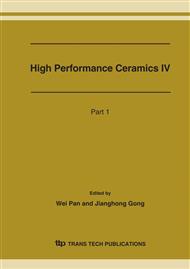p.2251
p.2254
p.2257
p.2260
p.2264
p.2267
p.2271
p.2275
p.2278
From Kaolins (with Addition of Al2O3) to Mullite Composite Nanocrystals: Experiments and Analysis
Abstract:
Natural and raw high-silica kaolins are firstly processed into fine kaolin powders with oxidation-reduction bleaching method before mixed with Al2O3 powders and then baked to produce mullite composite oxides at temperature between 1050-1150°C. The mullite composite oxides are further made into composite mullite nanocrystals by using open-system hydrothermal crystallization method under normal pressure. Analysis of the final products show that the mullite nanocrystals are texturally homogenous at an average size around 80-100 nm and have high thermal stability.
Info:
Periodical:
Pages:
2264-2266
Citation:
Online since:
April 2007
Authors:
Keywords:
Price:
Сopyright:
© 2007 Trans Tech Publications Ltd. All Rights Reserved
Share:
Citation:


